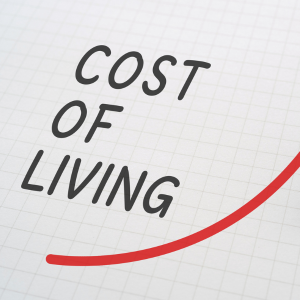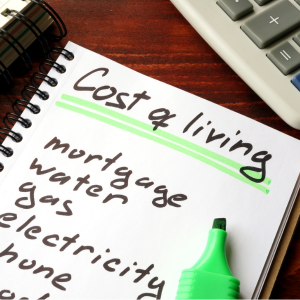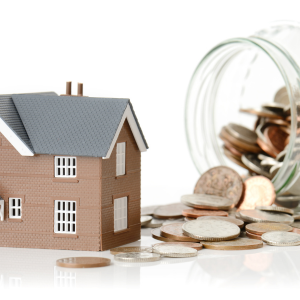
Anchorage isn’t cheap, but before you rule it out, remember that its expensive reputation doesn’t paint the full picture. Some costs may be higher than you expect, yet other parts of your budget might actually stretch further than where you currently live. The real question isn’t whether Anchorage is pricey, but whether it’s truly affordable for your lifestyle and whether you can make it work. And if you ever decide to relocate, Bethel cash buyers and other cities in Alaska can offer a quick and flexible selling option. Here’s a detailed guide on what it really costs to live in Anchorage!

How Much Is the Cost of Living in Anchorage, Alaska
The overall cost of living in Anchorage sits about 23% higher than the national average, but that’s just the starting point. What you actually spend each month depends on where you live in the city, how big your family is, and what kind of lifestyle you’re trying to maintain.
A single person needs roughly $3,800 to $4,200 per month to cover rent, food, transportation, and utilities without being extremely frugal. Families with two children are looking at a monthly cost of somewhere between $7,500 and $8,500.
The median home price runs around $410,000. If you’re renting, you can expect to pay approximately $1,450 for a two-bedroom apartment, although this amount may vary depending on the specific neighborhood you choose.
Anchorage, Alaska Cost of Living Breakdown
You can’t just look at one considerable number and consider it a done deal. Each part of your budget behaves differently up here, and some categories will surprise you more than others.
Housing Costs in Anchorage
You’re going to feel the pinch the most in Housing, and there’s really no way around it. If you’re buying, the $410,000 median price tag means you can expect a monthly mortgage payment of around $2,800. It climbs to $3,200 once you factor in property taxes and insurance.
Renting feels a bit more manageable on paper, but finding a decent place that doesn’t eat up half your paycheck takes some serious hunting. Studios start around $950, one-bedrooms go for about $1,200, and if you need more space than that, you’re easily pushing past $1,500.
The neighborhoods make a huge difference, too. South Anchorage and Eagle River are nice but pricey, while East Anchorage and Mountain View give you more bang for your buck without feeling like you’re living in the middle of nowhere.
Transportation Expenses
Your car situation is also going to cost you more than you think, even if you already own your vehicle outright. Gas prices in Anchorage run about 30 to 50 cents higher per gallon than the national average. That easily accumulates when you’re driving everywhere, as public transit is quite limited.
Car insurance is another thing. Alaska has some of the highest rates in the country, and you’ll probably pay around $1,800 to $2,200 annually for decent coverage.
Then there’s the maintenance side of things, which can become quite expensive when dealing with winter tires and engine block heaters not to mention all the wear and tear that comes from driving in sub-zero temperatures for months at a time.
Food and Grocery Prices
Groceries in Anchorage will make you miss your old Safeway or Kroger. Everything costs more because almost everything has to be shipped or flown in from somewhere else.
A gallon of milk runs about $4.50 to $5.50, bread costs around $4, and don’t even get us started on fresh produce. You’ll pay $3 for a single bell pepper on a bad week.
Your monthly grocery bill for one person usually lands between $400 and $500 if you’re cooking at home most of the time. Families can easily drop $1,000 to $1,200 per month just keeping the fridge stocked.
The good news is that places like Costco and Fred Meyer help you save a bit. Additionally, if you shop sales and buy in bulk when prices drop, you can keep costs somewhat under control.
Utilities and Energy Bills
Your utility bills in Anchorage will look significantly different depending on the time of year. Winter is harsh on your wallet because heating a home when the outside temperature is 15 degrees below zero isn’t cheap. Most people pay between $250 and $400 per month for natural gas or electricity for heating from November through March.
Summer is way easier. Your bills might drop to $100 or $150 when you’re barely using any heat at all. Electricity costs approximately 23 cents per kilowatt-hour, which is higher than the average in most of the Lower 48. Additionally, your water and sewer bill adds another $80 to $120 per month.
The internet is reasonably standard, costing around $70 to $100 per month, although your options are somewhat limited compared to those in larger cities.
Healthcare Costs
Healthcare in Anchorage costs more than you’d pay in most other states, and the options aren’t as plentiful as you might be used to. A basic doctor’s visit without insurance runs you about $150 to $200, and specialist appointments can easily hit $250 or more before you even get any tests done.
If you’ve got employer-sponsored insurance, you’re looking at monthly premiums around $450 to $600 for a family plan. Deductibles usually start at $3,000 and increase from there.
Prescription medications cost about the same as they do elsewhere. However, the real issue is that if you need specialized care that Anchorage doesn’t offer, you might have to fly to Seattle. That can be very expensive.
Dental and vision care aren’t usually included in standard health plans either. You will need to add an additional $100 to $200 per month to obtain decent coverage for checkups and glasses.
Childcare and Education Expenses
If you’ve got kids, childcare in Anchorage is going to be one of your most significant monthly expenses outside of housing. Full-time daycare for an infant costs between $1,200 and $1,500 per month, and the price remains relatively stable as the child grows older. Toddlers and preschoolers still cost around $1,000 to $1,300 per month.
Before- and after-school care for elementary-aged kids adds $400 to $600 to your budget if both parents are working. The public schools are free, like anywhere else. Still, many families end up paying for extracurricular activities, sports, and other expenses that can add up to a few hundred dollars each season.
Private school tuition starts around $8,000 annually for elementary school and can go significantly higher for high school. Unless you’re really committed to that route, most people stick with the public system and just deal with whatever comes with it.
Anchorage, Alaska Monthly Living Costs
When you add everything up and look at what you’re actually spending month to month, the numbers can feel overwhelming at first. A single person living alone and keeping things relatively simple will spend at least $3,800 per year. That’s if you’re being careful and not going out to eat every weekend or buying a bunch of stuff you don’t really need.
Couples without children usually earn somewhere between $6,000 and $6,500 per month. Then, once you throw children into the mix, you’re easily at $7,500 or higher, depending on how many mouths you’re feeding and what kind of lifestyle you’re trying to maintain.
The tricky part is that these aren’t averages you can just cut down by being frugal. Most of these expenses are pretty fixed. There’s only so much trimming you can do before you’re genuinely sacrificing comfort or safety.
Average Salaries and Wages in Anchorage, Alaska
Wages in Anchorage tend to be higher than in many other places, which helps offset some of the high living costs. The median household income sits around $88,000. However, you’re also paying 23% more for basically everything.
Entry-level jobs in retail or food service start around $15 to $17 per hour, and skilled trades like electricians or plumbers can pull in $70,000 to $90,000 annually once they’ve got some experience under their belt.
Healthcare workers, engineers, and individuals working in the oil and gas industry perform even better. Nurses make around $80,000 on average, and petroleum engineers can clear six figures pretty easily.
You really have to find a job that pays well enough to actually let you live comfortably instead of just scraping by. That’s honestly easier said than done for many people who move here without something already lined up.
Income vs. Cost of Living Ratio in Anchorage, Alaska
Yes, you’re making more money in Anchorage, but you’re also spending more. The question is whether it all evens out or if you’re actually getting ahead.
For many people, the $88,000 median household income sounds great until they realize they’re spending $7,000 or $8,000 per month just to live a relatively everyday life. The math works out to about 35% to 40% of your gross income going straight to housing. This is higher than the recommended 30% that financial advisors often cite.
If you’re single and making $60,000, you can live decently, but you’re not exactly building a massive savings account every month.
Families really need both adults working and pulling in at least $90,000 combined to feel like they’re not constantly stressed about money. Even then, you’re probably not taking fancy vacations or buying new cars every few years.
What Makes Anchorage Different from Other Alaska Cities
Living in Anchorage compared to a smaller Alaska town can shift the cost of nearly everything, and understanding those differences can help you decide whether Anchorage is truly the right fit. As you weigh your options, remember that Anchorage Home Buyers can help if you ever choose to make a move.
- You’ve got actual stores here. There are real grocery stores, Target, Costco, all that stuff. This means you’re not paying the exorbitant prices that people in smaller towns often face. A gallon of milk in Anchorage costs $5, but in Nome or Bethel it’s $10 or more.
- You don’t have to fly or take a ferry just to go somewhere else. This saves you a lot of money compared to living in Juneau or any of the island communities. Road access to the rest of the state means your transportation costs stay way more reasonable.
- The job market is way better here. There are more opportunities and higher wages than you’ll find in Fairbanks or anywhere else in the state. Most of Alaska’s corporate headquarters and major employers are based in Anchorage.
- Housing costs more here than it does in smaller cities like Kenai or Wasilla. If you’re willing to commute or live a bit outside the city, you can save some serious money without completely isolating yourself from civilization.
Note, though, that you pay more for housing in Anchorage, but you save on basically everything else compared to rural Alaska. For most people, that makes sense unless you’ve got a really high-paying job waiting for you in one of those tiny towns.

Seasonal Cost Variations in Anchorage
Your expenses in Anchorage vary depending on the time of year. You need to budget for that, or you’ll get blindsided when winter arrives. The difference between your summer bills and your winter bills can be hundreds of dollars every single month, and it’s not just one thing. It’s everything piling up at once.
Winter Heating and Energy Costs
Your utility bills will go sky high during winter, and there’s really no way to sugarcoat it. From November to March, you can expect heating bills of between $250 and $400 per month. That’s if you’re not trying to keep your house at 75 degrees the whole time.
Your electricity usage also increases because you’re running lights more frequently. It gets dark at like 4 pm in the dead of winter, so you’re not exactly saving on that front either.
Summer Transportation and Travel Expenses
Summer changes everything and makes your transportation costs shoot up instead, especially if you’re the kind of person who actually wants to enjoy living in Alaska.
Gas prices tend to spike slightly when the tourism season arrives. If you’re driving out to go fishing or hiking every weekend, you’re burning through way more fuel than you do in winter.
Many people also fly out to visit family or take actual vacations during the summer months because winter is too miserable. Round-trip tickets to Seattle or anywhere else typically cost $400 to $600 per person.
Year-Round Food Price Fluctuations
Food prices in Anchorage bounce around, too, and it’s not always predictable. Fresh produce costs the most in winter because everything has to be shipped in, and there’s obviously nothing growing locally. That $3 bell pepper can increase in value to $4 or $5 between December and February.
Summer offers some relief when you can hit up the farmers’ markets and get local stuff. Additionally, shipping costs decrease slightly when the weather isn’t delaying cargo as much.
Hidden Costs of Living in Alaska’s Largest City
There’s a whole bunch of expenses in Anchorage that nobody really warns you about until you’ve already moved here. These can add up over time and mess with your budget in ways you didn’t plan for.
Alaska Permanent Fund Dividend Considerations
So technically, the Permanent Fund Dividend isn’t a cost, but it affects how you think about money up here, and you need to understand how it actually works. Every year, Alaska residents receive a check from the state, typically ranging from $1,000 to $2,000 per person. Many people rely on that money to cover significant expenses or catch up on overdue bills.
The problem is that the amount changes every single year. You can’t really budget around it because you never know exactly what you’re getting until they announce it.
Shipping and Delivery Fees
Shipping costs in Anchorage can be a significant stress if you frequently shop online. Many retailers either don’t ship to Alaska at all or charge an additional fee. This is because they treat it like some kind of international destination, even though we’re literally part of the United States.
You’ll add something to your cart, get all the way to checkout, and then see a $30 shipping fee on a $40 item. This makes the whole thing pointless. Amazon Prime helps with some things, but even they don’t offer free two-day shipping on everything.
Vehicle Maintenance in Extreme Weather
Your car takes a beating in Anchorage, and the maintenance costs can be super expensive. You need winter tires every year unless you want to slide around like you’re driving on an ice rink. A decent set costs $600 to $1,000, depending on your vehicle.
Engine block heaters aren’t optional either. You need one installed if your car doesn’t already have it, and you’ll pay around $150 to $300 for that. Most people end up spending an extra $1,000 to $1,500 annually on vehicle maintenance compared to what they paid in warmer climates.
Budget Tips for Living in Anchorage
You can’t make Anchorage inexpensive, but you can make it more manageable if you’re strategic with your spending. The people who thrive here aren’t necessarily the ones earning the most; they’re the ones who’ve learned where to cut costs without sacrificing their quality of life. And if you’re thinking about simplifying your housing situation, here’s how Anchorage Home Buyers can help.
Take Advantage of No State Income Tax
Alaska doesn’t have state income tax, and that’s one of the biggest financial perks of living here. If you were making $80,000 in California or Oregon, you’d be losing around $5,000 to $6,000 annually to state taxes. That money stays in your pocket in Anchorage.
Our tip is to actually treat extra money like savings instead of just letting it disappear into your regular spending. Set up an automatic transfer into a savings account for whatever you would’ve paid in state taxes. That way, you’ll have a decent emergency fund building up without even thinking about it.
Reduce Heating and Utility Expenses
You can’t avoid heating costs in winter, but you can definitely reduce them. Keeping your thermostat at 68 instead of 72 saves you around $50 to $75 per month. Yes, it’s a little cooler, but throw on a sweater and you’ll survive.
Blackout curtains actually help a lot because they keep the heat from escaping through your windows. They’re like $30 at Target, so it’s not a huge investment.
If you’re renting, ask your landlord about installing a programmable thermostat. This will help you lower the temperature while you’re at work or asleep, cutting your heating bill by 10% to 15% without you even noticing the difference.
Innovative Shopping Strategies for Groceries
Groceries are expensive in Anchorage, but you don’t have just to accept whatever prices they throw at you. You can visit Costco and Fred Meyer if you’re willing to buy in bulk and actually use the items you purchase before they expire.
Stock up on meat when it goes on sale and freeze it for later use. You can save $100 or more per month simply by buying chicken or ground beef when it’s on sale and portioning it out yourself.
The farmers’ markets in summer are great for produce. The stuff tastes better anyway since it’s actually fresh instead of being shipped from California. Don’t buy from the corner stores and gas stations for everything except emergencies. They charge you approximately 30% more than regular grocery stores, which is very expensive in the long run.

Is Anchorage Affordable for Your Lifestyle?
The honest answer? It depends entirely on what you want out of life and what you’re willing to give up to live here. If you’re the type who needs to eat out three times a week, buy new clothes frequently, and take expensive trips every few months, Anchorage may feel like a tight budget unless you’re earning a substantial income.
But if you’re okay with a simpler lifestyle, cooking at home most nights, and finding free or cheap ways to enjoy the outdoors, you can make it work here on a moderate income.
The people who struggle the most are those who move here expecting to maintain the same lifestyle they had in a cheaper location, and that’s just not realistic. You have to be willing to adjust your spending habits and priorities, or you’ll be constantly stressed about money and likely end up leaving within a year or two.
Sell Your Anchorage Home to Cash Buyers!
If you’ve realized that Anchorage no longer fits your budget or you need to relocate quickly for any reason, consider selling your home to cash home buyers in Anchorage and surrounding Alaska cities for a faster, more convenient process.
Traditional home sales in Anchorage can take months, especially in winter when few people are looking at houses. You’re stuck paying that mortgage and those expensive utility bills the entire time you’re waiting.
Cash buyers can close in a week or two, which means you’re done with all those costs way faster, and you can move on to whatever’s next. You won’t get top dollar compared to listing with a realtor, but you also don’t have to deal with repairs, staging, or any of that hassle.
For some people, especially those relocating for work or dealing with financial pressure, getting out quickly matters more.
Key Takeaways: Anchorage, Alaska Cost of Living
Anchorage costs about 23% more than most places. You’re looking at $3,800 to $4,200 per month if you’re single, or $7,500 to $8,500 for a family. Housing and winter heating bills can be costly, but the median household income of $88,000, combined with the absence of state income tax, helps offset these expenses. You can make it work here if you’re smart about shopping in bulk, keeping your thermostat set to a reasonable temperature, and not expecting to maintain the same lifestyle you had somewhere else at a lower cost. If Anchorage prices are squeezing you too hard and you need to sell quickly, Anchorage Home Buyers will buy your house for cash and close in a week or two, with no repairs and no waiting. Contact us at (907) 331-4472 or complete the form below to receive your offer today.
Helpful Anchorage Blog Articles

